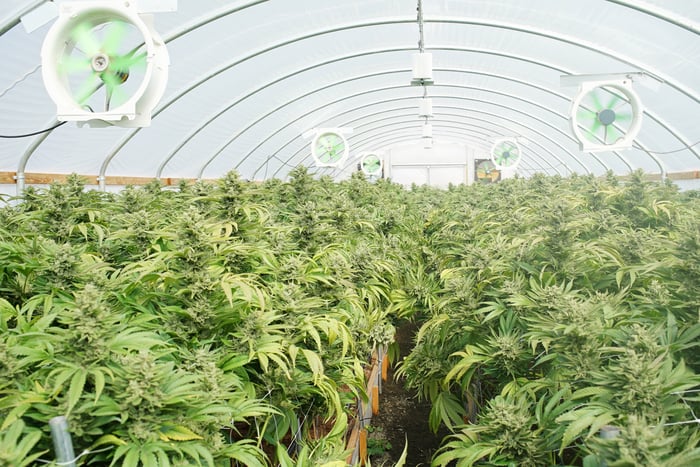Right now, there are few industries growing more quickly and consistently than legal cannabis. Estimates from cannabis research firm ArcView, in partnership with BDS Analytics, call for North American sales growth to average 28% each year through 2021, leading to almost $25 billion in sales. A decade from now, we could be looking at around $47 billion in annual sales. The industry is quite literally flowering before investors' eyes.
We've also witnessed a clear and concise shift in the way the public views marijuana -- at least within the United States. Over the past year, five national polls -- CBS News, Gallup, Fox News, Pew Research Center, and the independent Quinnipiac University -- all found strong support for legalization, ranging from 59% to 64%. Quinnipiac's survey also found overwhelming favorability toward medicinal weed, with 94% of respondents in favor of legalization compared to just 4% who opposed the idea.
With figures like this, it's no wonder that pot stocks were practically unstoppable in 2016 and 2017. Many of the largest weed stocks had gained in excess of 1,000% over the trailing-two-year period when the calendar switched over to 2018.

Image source: Getty Images.
What's wrong with pot stocks?
But something has been amiss in 2018. Since the North American Marijuana Index peaked at a reading of 363.31 on Jan. 23, 2018, it's lost 39% of its value through Monday, April 9, 2018. The last time the index was this low was the Friday before Christmas. If the cannabis industry offers such impressive growth and consumer support, what the heck is going on with marijuana stocks? The answer likely involves a confluence of the following six catalysts.
1. Canada delayed its recreational marijuana launch date
This first problem we run into is that Canada's expected legalization of recreational weed hit a snag. It's not so much that lawmakers in parliament aren't likely to vote the Cannabis Act (officially bill C-45) into law in June so much as the infrastructure in select provinces needs time to ready itself prior to the launch of adult sales.
Right now, a Senate vote is scheduled for June 7, with the strong likelihood that the Cannabis Act will be signed into law soon thereafter. However, provinces had asked for an additional eight to 12 weeks post-approval to get cannabis from growers into approved dispensaries. This, along with the need to solidify regulation, pushed back an expected launch date in July 2018 to sometime in August or September.
In the long run, this doesn't change a thing about the cannabis industry and probably doesn't do one ounce of harm to pot stocks. However, with volatility high in marijuana stocks and investors who don't plan on staying for the long haul, this delay caused some investors to abandon ship.

Image source: Getty Images.
2. Oversupply concerns are taking their toll
Next, there are growing concerns that capacity expansion among Canadian growers is going to lead to an epic glut of marijuana that drives down per-gram cannabis prices and wrecks margins.
There are currently more than 90 licensed cultivators in Canada, and this figure is only expected to grow. Many of these growers have been using every ounce of capital available, as well as utilizing bought-deal offerings to raise additional capital to expand their growing capacity. Six of the largest projected producers -- Canopy Growth Corp (CGC -1.01%), Aurora Cannabis (ACB -2.79%), Aphria, MedReleaf, OrganiGram Holdings, and Hydropthecary Corp. -- are expected to generate around 1.17 million kilograms per year by 2020.
Yet domestic annual demand in Canada is projected to be closer to 800,000 kilograms. If we add in the other licensed growers, it's possible we could see 1.8 million kilograms to 2 million kilograms in annual production, or perhaps 1 million kilograms of domestic oversupply.
Where will this oversupply go? It's possible that it all will be exported to foreign countries that have legalized medicinal weed. But it's unclear if these countries can absorb such an incredible amount of domestic oversupply. Until we get a better read on what supply and demand will look like, pot stocks could struggle.

Jeff Sessions addressing an audience. Image source: Jeff Sessions' Senate webpage.
3. Jeff Sessions put his foot down
Third, investors have been none too pleased with U.S. Attorney General Jeff Sessions' antics. Last year, Sessions, who's an ardent opponent of marijuana, requested that the Rohrabacher-Farr Amendment be repealed. This is the legislation passed with each federal spending bill since 2014 that's protected medical marijuana businesses from federal prosecution. Sessions was unsuccessful in his bid to get this Amendment repealed.
However, he was successful in rescinding the Cole memo on Jan. 4, 2018. The Cole memo, written by former Deputy Attorney General James Cole, outlined a series of loose rules that legalized states would follow to keep the federal government off their backs. These rules included keeping adolescents away from pot, as well as keeping cannabis grown in a state within its borders. Its rescinding paves the way for state-level prosecutors to use their discretion in bringing charges against individuals and/or businesses that violate the Controlled Substances Act.
In effect, Sessions has put his foot down and ensured that Canada has virtually no access to the U.S. market, and investors obviously aren't happy that the U.S. marijuana industry is stuck in neutral.

Image source: Getty Images.
4. Dilution rears its head
Another serious issue with cannabis stocks is shareholder dilution. As noted, marijuana growers in Canada are aiming to expand their capacity as quickly as their wallets will allow. Unfortunately, most of these companies are still losing money, and even if they are profitable, they're generating only a few million dollars in annual cash flow. In order to get the tens of millions of dollars needed to undertake these expansion projects, Canadian growers have turned to bought-deal offerings. These are deals that allow publicly traded Canadian companies to sell common stock, convertible debentures, warrants, and/or options.
The good news is that there have been more than enough investors via bought-deal offerings to fund seemingly every capacity expansion project. The downside is that these capital raises wind up either immediately, or within a matter of months or years, ballooning a company's outstanding share count. That makes existing shares less scarce because it dilutes them. It also makes it considerably tougher for a company to turn a meaningful profit since net income will be divided by an increasingly larger number of outstanding shares.
For example, Aurora Cannabis has seen its Canadian-listed outstanding shares grow by more than 2,900%, to almost 490 million, in less than four years. Worse yet, it's not done. Aurora's acquisition of CanniMed Therapeutics was a cash-and-stock deal, and it has more convertible debentures and options yet to be factored into its outstanding share count. Dilution is the silent killer of pot stocks.

Image source: Getty Images.
5. Fundamental investors make their presence known
A fifth cause for concern is that marijuana stocks may not generate as much green as investors expect. Aside from oversupply worries that could wreck margins and the impact of dilution that could weigh down earnings per share, most cannabis companies are too busy expanding their capacity and reinvesting every cent they have in other aspects of innovation -- so profitability isn't really in the picture.
When the proverbial green flag waves in Canada by this summer, most pot stocks will be losing money. By this time next year, even though some could be making money, the price-to-earnings (P/E) ratio for many likely will be many times higher than the average P/E ratio for the broader stock market. In other words, even when taking into account the fact that this a growth industry, pot stocks look fundamentally flawed.
For instance, Canopy Growth Corp., the pot stock with the largest market cap, has an unparalleled distribution channel and could easily top 300,000 kilograms in annual production once its greenhouses in British Columbia are complete. But because it's investing so much into expansion and its distribution channels, it may not even turn a profit until 2020. Are investors willing to pay a hefty premium on Canopy if it's still two more years from recurring profits? I'm not so certain.

Image source: Getty Images.
6. Normal profit-taking and tax-based selling
Finally, there's always the possibility that recent weakness in marijuana stocks could be the result of normal profit-taking and tax-based selling. Let's not forget that many of these stocks were up by four-digit percentages in a two-year stretch, so taking money off the table and locking in gains for an industry that's largely still losing money isn't a bad idea.
What's more, locking in those gains after the end of the year may provide two advantages. First, investors' capital gains are pushed out for another year. Secondly -- at least for U.S. investors -- the passage of the Tax Cuts and Jobs Act may wind up reducing the capital gains tax on short-term investments (those held 365 days or less).
Regardless of the exact reasoning, marijuana stocks aren't doing well at the moment, and that's something for current and prospective investors to keep in mind.





